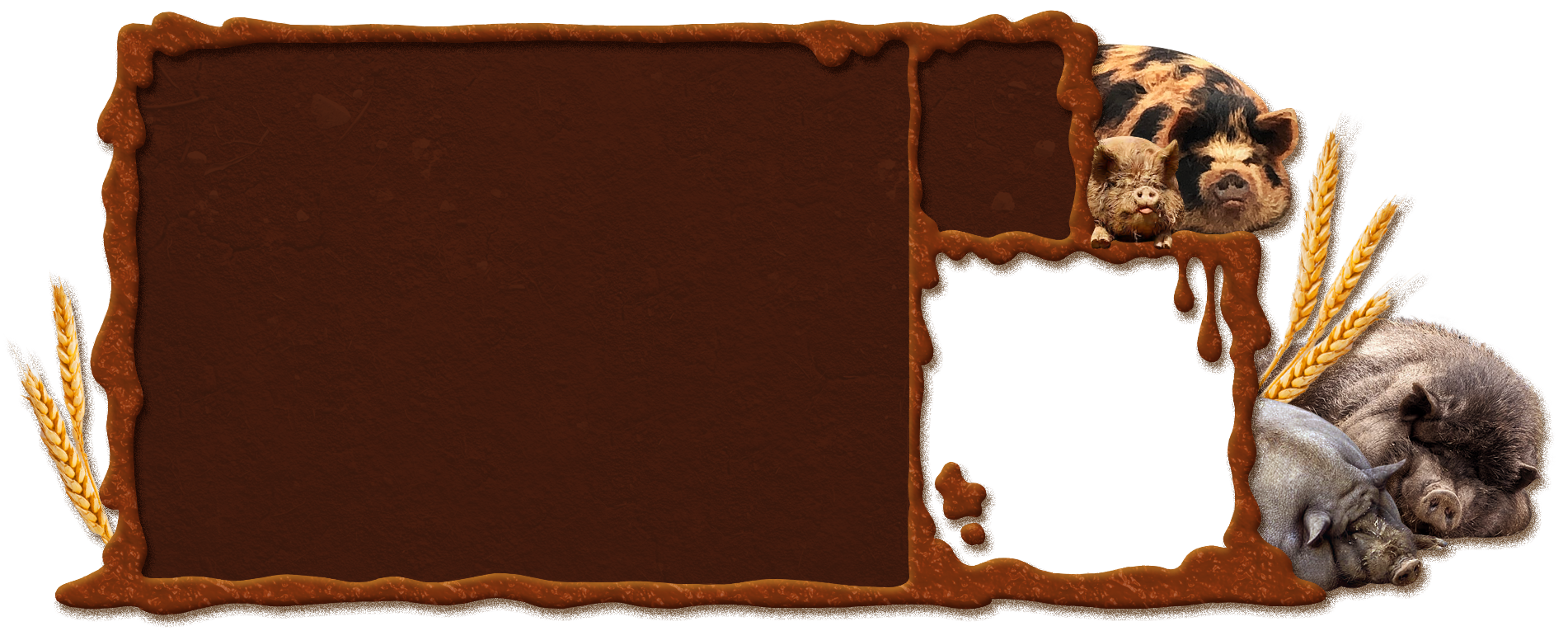makes them so incredibly special! not exhaustive, just gushy and lovey and infodumpy. i like pigs.
kunekune pigs!
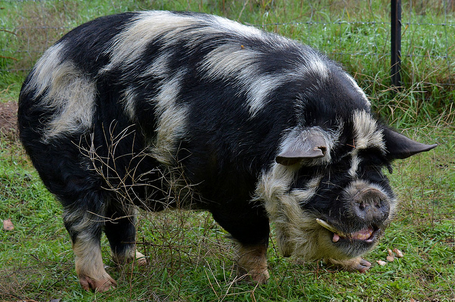
the pig of all time and my personal favourite, the kunekune!! these charming little homestead hogs are known for their laidback and friendly personalities, which are unmatched by any other breed of swine. extremely outgoing, they thrive on human company and love to spend time with their owners throughout the day, relaxing and playing and sharing sweet little affections. they love a good scratch.
though boars can be aggressive to each other when sows are in season, kunekunes are very trustworthy and easy-to-handle pigs, gentle around children and highly intelligent. for this reason, they make excellent pets - especially for first time pig owners! they’re also popular in zoos, petting farms, and even therapy programs!
the name kunekune literally means ‘fat and round’ in maori, which is only right for such a characteristically oblong beast. recognizable for being squat in every sense of the word, their upturned noses squish into their faces, giving them handsome eyebrow folds and an adorable kitty smile that is sometimes punctuated by short, sharp tusks at both ends. their coat colours and textures vary from pig to pig, with many being black, white, gold or tan - sometimes with randomly distributed spots and patches. they can be silky and sleek or curly and unkempt, meaning each kunekune can be distinguished by awesome hairdo alone!
another iconic feature of the kunekune is their wattles, or tassels, which are about 4cm long and hang from their lower jaws. not all kunekune pigs have tassels, though, and some are even born with odd amounts dangling from only one side. these have no known biological function, but they’re super cute!!
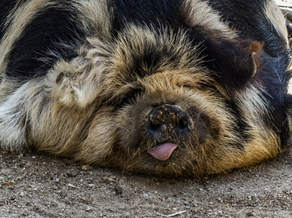
like all pigs, kunekunes are omnivorous, but require less protein than most breeds. their upturned snout is made for grazing, not rooting, and will thrive and fatten on a diet of grass alone!
a new zealand breed, kunekunes were kept by the maori people and allowed to roam their villages as both valuable livestock and beloved companions. their origins are uncertain due to a lack of documentation on their introduction and early population numbers, but the general consensus is that kunekunes were brought to new zealand in the 1800s by whalers who were operating in nearby waters and traded with the maoris. pigs with similar characteristics are found in asia, south america, and the polynesian islands, but the resemblance is small and suggests only a possible common ancestry. they’re mystery hogs! and survivors - once upon a time, these delightful beasts were nearly extinct.
in the late 1970s, it was determined that there were only about fifty purebred kunekunes left in new zealand and the breed would need help to survive. from a base stock of only six sows and three boars, wildlife park owners michael willis and john simister single-handedly saved the breed from extinction!! thanks to them, we can bask in the curly, smiley presence of kunekune pigs today!
mangalica pigs!
also known as wooly pigs and sheep pigs, the most remarkable thing about the magnificent mangalica is its famously frizzy coat of fur! in winter, this fur is long, thick and curly like fleece, falling down over their faces like a fashionable fringe, while in spring it turns stiff and shiny. it’s the last pig in existence to sport such a charming characteristic, as the only other pig known to have curly hair is the extinct lincolnshire curly coat pig, which disappeared shortly after the second world war.
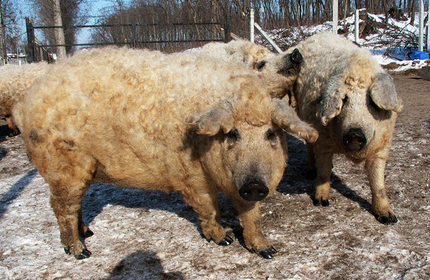
once known as the mangalitsa, this breed is indigenous to hungary and its name means ‘hog with a lot of lard’ - meaning its meat has high fat content. they’re large and round with high backs and stout bellies!
a criminally underrated feature of the mangalica is the black colouration of their noses, toes, and the skin area of their eyes, which gives them almost puppy-like snouts and blotchy eyeshadow!
beneath their iconic coat awaits many more surprises, though, as mangalica swine are known for their doglike behaviours! if treated well, they’ll be as tame as a family pet - compassionate and sensitive with an endless desire to play. they get along well with cats and dogs, are hardy enough to withstand snowy climates, and live up to three times longer than more common breeds of pig (up to 20 years)!! mother mangalicas also have strong maternal instincts, caring for their striped little squeakers attentively. for these reasons, they’ve become a popular hobby breed.
there are three existing colour varieties of mangalica known as blonde, swallow-bellied (black with a blonde belly) and red, each with their own unique charm and breeding history. the blonde variety was developed from older, hardier types of hungarian pig crossed with the european wild boar, but almost disappeared after the collapse of austria-hungary due to changes in dietary habits. luckily though, passionate breeders like peter toth worked hard to revive the breed in the 1990s. the red variety was created by crossing the blonde mangalica with the szalonta breed, and the swallow-bellied type descended from the extinct black mangalica. other varieties sadly lost to time are the wolf and the baris mangalica, who were no doubt just as handsome as their surviving siblings.
taihu pigs!
one of the most charismatic breeds of pig, taihus are incredibly placid - docile, friendly and gentle, with an easy-to-control attitude and low environmental impact that makes them popular with beginner breeders. they get along well with other animals and don’t have a pushy bone in their body! though much like the basset hound, their loose, drooping skin hints at a lazy personality. extremely sedentary, these pigs are happy to lie around and do nothing at all!
(their appearance is actually unrelated to their personality, but don’t saggy things just look so adorably sleepy all the time?)
a medium-sized, sparsely haired pig, taihus come in a range of wisened greys and striking blacks. they have pendulous, low-hanging ears and deep fatty folds in their faces that scrunch like well-loved bedcovers at the slope of their snouts. some lucky swine have one or more pink socks extending from their hooves, or pink splotches at the dip of their bellies and the tip of their noses!
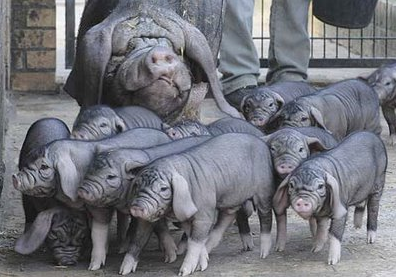
originating from china, the taihu pig can be found in the narrow region of mild-tropical climate bordering the major pig raising areas of shanghai, also known as the lower yangtze river basin. they have a number of divisions, classed by some as strains and others as separate breeds, with all types of taihu pig famed for their high fertility, excellent mothering ability, and large litters of up to twenty piglets! this, along with their resistance to disease, has resulted in worldwide interest by smitten breeders and inspired genetic engineers.
the taihu pig, or more specifically its meishan division, is possibly the oldest heritage swine breed in the world!
vietnamese pot-bellied pigs!
considerably smaller (about 36cm tall) than standard american and european farm pigs, vietnamese pot-bellies are a pig breed that has captured the hearts of pet owners everywhere! they are robust, resistant to disease and parasites, and particularly well-adapted to muddy and marshy terrain with their unique plantigrade feet.
yes, in pig-keeping circles, the pot-belly is the start of the show!
smart and curious with personalities similar to those of large dogs, pot-bellies are social critters. they flourish in big families where they can receive a lot of attention, and will form close bonds with their humans and fellow pets, especially when raised together from a young age. they can be taught to do tricks and walk on a leash, and respect owners who establish clear rules and boundaries over those who spoil them rotten. still, they love to be massaged and pampered, brushed, bathed, and tucked in at night!
the most iconic feature of the pot-belly is, of course, their big sagging tummies, which in pregnant sows can be so large that they drag along the ground! they have pronounced sway backs and small heads with upturned snouts, giving them a pug-like “loaf” sort of charm that is only built upon by their sightly skin folds and heavy jowls. most are black with white markings taking the form of saddles, belt stripes, or fun and unruly blotches.
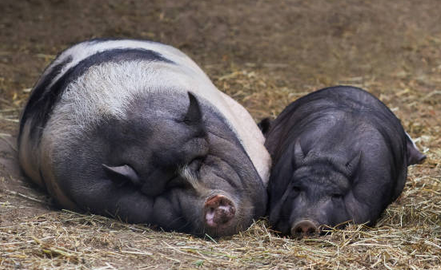
despite their obvious appeal and even temperaments, pot-bellies are a demanding pet - something many people don’t care to acknowledge. they require a lot of care and mental stimulation. in the 80s and 90s, pot-bellies became a fad pet - people would buy them as piglets because they were cute and easygoing, then abandon them as they grew larger and developed strong, unrestrained personalities due to lack of training.
nowadays, ‘pot-belly pig’ doesn’t refer to a single specific breed. because vietnamese pot-bellies are the same species as ordinary farmyard pigs and wild boars, they are capable of interbreeding - and have done so many times to produce a large group of domestic mini pigs referred to altogether as ‘pot-bellies’. these pigs share significant visual characteristics with their vietnamese ancestors, but aren't closely related in terms of genetics.
the indigenous vietnamese pot-belly exists almost exclusively in mountainous vietnam and thailand at this point!
visayan warty pigs!
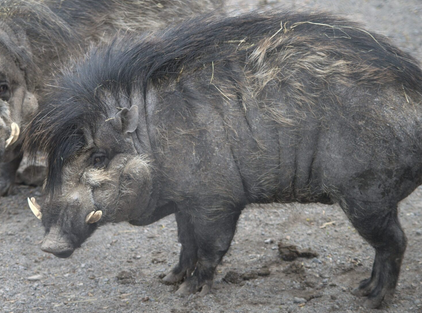
the visayan warty pig is a wild hog species that lives on six of the philippines visayan islands - panay, cebu, negros, guimaras, siquijor and masbate. they’re known by many names in the region, with most translating to ‘wild boar’, ‘forest pig’, or ‘dark pig’. fitting for such striking forest-dwellers!
as their name suggests, warty pigs have fleshy warts protruding from their faces that act as a natural defence against rival pigs during fights. these warts are also devilishly handsome, often contrasting the dark visages of the pigs with a bright tuft of fur - like a moustache or beauty mark! they have long, crooked snouts and four protruding tusks that curl their faces into a permanent smile.
male warty pigs also grow funky rockstar manes that run from their foreheads to their hindquarters in dark, floppy tufts. these will rise and prickle when they feel threatened, much like the back hair of a cat!
on one magical occasion, a warty pig was seen using a tool. pig tools! it picked up a piece of bark in its mouth and started digging with it, pushing the soil around to build a nest just in time for the springtime piglet rush! this is an incredible feat for any animal, showing the kind of intelligence that set humans apart from animals almost three million years ago.
unfortunately, due to habitat loss and overhunting, these spunky swines are critically endangered. their forest homes are being cleared for crops, reducing space for their food sources to grow and flourish. several breeding programs worldwide are attempting to save them.
neijiang pigs!
an obscure but mesmerising breed, the neijiang’s charisma shines even with limited documentation. from the tips of their lop ears to the angular dip of their stomachs, these large, peppered-with-fluff pigs ooze with quirkiness!
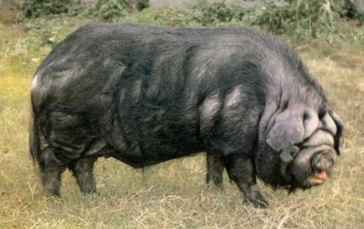
structured almost like a steed animal, neijiangs are comparatively big pigs with strong body constitution (they’re healthy!) and remarkably thick, white skin. their most captivating feature is of course their handsome fat folds, which overlap their elbow joints and descend in rolls over their faces, forming grand-looking brows, face wrinkles, and jowls. at their backs and hindquarters, this fat can reach up to 6cm thick!
another distinct feature of neijiangs are their hard hooves, which are commonly likened to those of mules. this hoof type has captivated countless authors throughout history, yet of all the mule-footed swine described, the noble neijiangs are the only pigs with a history of agricultural use!
they were developed in southwest china where the climate is mild, farming is well-developed, and the area is rich in feed supplies. while not as robust as some other breeds, neijiang pigs are well-tailored to the environment they live in, thriving in the sichuan basin as honourable livestock.
ossabaw island pigs!
the ossabaw island pig is a special breed descended from hogs released on the island in the 16th century. this makes them the closest genetic representative of the ancient pig stock that was traded by spanish and portuguese explorers on their way to the west! though considered by many to be a mainland pig, they actually originate from the canary islands and have connections to some asian breeds of swine.

they’re intelligent and friendly individuals, with a hardy nature well-suited for free range farming. however some of their biggest fans are scientists, not farmers, as they provide extraordinary opportunities to study long-term natural populations!
unique among pigkind, ossabaws have been shaped by natural selection in a challenging environment known for humidity, heat, and seasonal food scarcity. although they can be as small as 100 pounds, these tenacious swine are able to store astounding amounts of fat (making them resemble charming pottery projects) in order to survive during famine! this can be a blessing and a curse, though, as their owners have to watch their feeds closely to prevent obesity.
their small stature is a result of insular dwarfism, which means the limited amount of space on ossabaw island prevents them from getting too chunky! ossabaws born in off-island farms have grown up to twice the size of their homeland cousins!!
though usually a stunning black colour, their most famous appearance is wonderfully toasty: golden-brown and spotted all over with dark patches. they’re hairy with heavy bristles on their heads, necks and backs, which comes together as a stylish body-length mohawk and occasionally tips their ears in a koala-like, fuzzy droop. despite their long snouts and heavy heads, they can move with incredible speed and agility through the dense undergrowth.
taiwanese green glowing pigs!
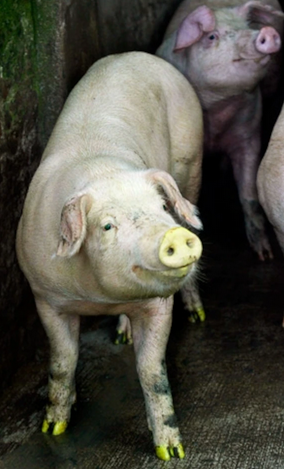
maybe pigs can’t fly, but they can glow! in taiwan, genetic engineers have developed three luminous green pigs by injecting fluorescent jellyfish protein into the embryos of pregnant sows. this procedure boosted the island’s stem cell research and assisted with the study of human disease, allowing scientists to track the development of injected cells without the need for invasive tests!
the result is a magical breed, tinged greenish-yellow in the sunlight and shining brightly from their nose-tips to their toes in ultraviolet. even their hearts are green, an amazing new stride in genetics that had never been accomplished before! in structure and in health though, they’re no different to their non-glowing counterparts - smooth-snouted, lop eared, chunky, happy beasts.
their snouts and their painted-looking hooves are especially enchanting.
tibetan pigs!
all the way from the qinghai-tibet plateau comes the delightful tibetan pig! small and skittish, these little guys are known to be super alert - always running and jumping over obstacles, with quick responses to noise and smell. in this way, they’re pretty easy to herd, but harder to bond with as they prefer to chill out in the safe company of their fellow swine. they're well-adapted to the high, cold climate of their forest homes.
relatively slim for a domestic pig, tibetans are not very heavy (only growing to about 35kg!) and boast a streamlined but shaggy look. long and dense black bristles hang low from their tummies and sprout from their elbows in a fetching manner, contrasted cutely by dainty grey trotters. on the tops of their heads, they sport puppy-like perked ears!
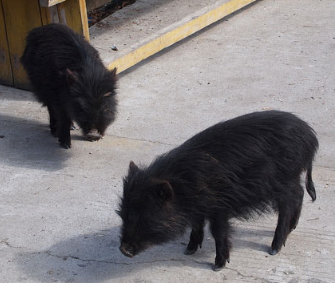
with their long, straight snouts, they dig holes in the dirt and unearth underground rootstock of herbal medicines. most pigs cannot survive on sparse shrubs, stems and wild seeds, but tibetan pigs have highly developed digestive organs to help them pull through - their intestines are 36 times longer than their bodies!
though found exclusively throughout the tibetan highlands, their origins are a mystery, as there’s little evidence of either local domestication or exotic migration of the breed. with the exception of yaks, the domestic animals kept by tibetan people were generally introduced during the period of their colonisation. it's most likely, though, that the pigs were domesticated locally. 5000-year-old pig bones have been found repeatedly in tibetan archaeological sites, and the genetic diversity across the highlands supports their development!
image sources!

